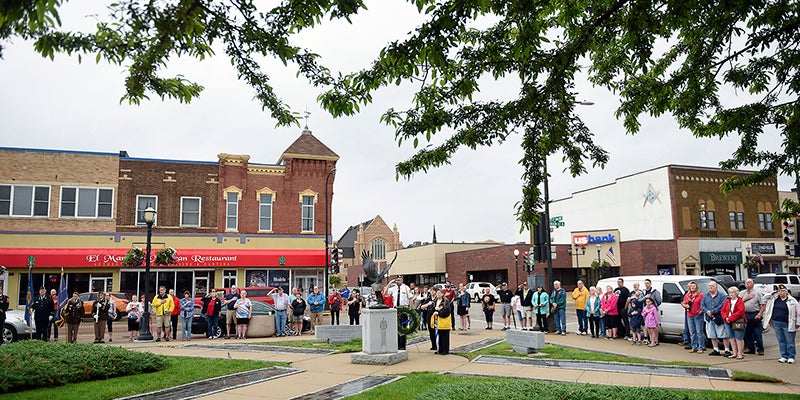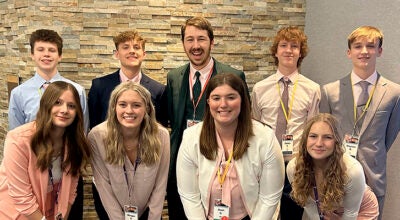Pacelli’s rocket boys recall Mousenik days
Published 10:29 am Saturday, November 14, 2009
They called it Mousenik.
In 1957 three Pacelli High School students launched a four-foot, 10-inch rocket into the air — with a rodent, named Ulysses, as its sole passenger, according to a 1957 Associated Press report.
The 50-cent mouse did not survive the mission, reaching an altitude of 1,642 feet, at up to 221.5 miles per hour. Nonetheless, the launch became the Austin Rocket Society’s international claim to fame.
Richard King, Leonard Paul Germer and Gary Solyst constructed and launched hundreds of rockets, including Mousenik, as high school students in the 1950s. A few others belonged to the club too, but these three founding members were the most involved. After Mousenik, the group doubled in size.
King and Germer returned to their alma mater Friday to talk about their adventures with current students.
“In 1955 we built one rocket per week, some weeks maybe four of five,” Germer told an auditorium full of students.
But, it was not until the launch of Mousenik that the public started to pay attention.
The Associated Press covered Mousenik I, and ABC TV filmed a launch live, airing it nationwide.
The boys soon found out that the mission was even written up in a Russian newspaper, mocking the U.S. by saying American high school kids beat them to the sky, King said.
They were also featured in LIFE Magazine — fame that landed King a date to the prom, he said.
Pacelli students watched the film October Sky before the talk Friday. The movie, which is based on the memoir “Rocket Boys” by NASA’s Homer Hickam, is about high school boys in West Virginia who built rockets in the 1950s.
Germer and King say that it is their story, and that the film may have actually been inspired by the Austin Rocket Society.
“All you have to do is change the location to Austin, and the names of the people,” Germer said.
King, Germer and Solyst taught themselves how to build rockets, using principles they learned in math and science class. They also got some help from an issue of Scientific American that Germer stumbled upon in the library, which had instructions on rocket-building techniques, they said.
Science fiction books and TV originally piqued their interest in rockets.
The three, under the guidance of physics, chemistry and science instructor Sister M. Duns Scotus, launched Mousenik I Nov. 30, 1957, Mousenik II Dec. 29, and Mousenik III Dec. 31. The final Mousenik contained a mechanical rather than a live mouse, as their former experiments had gotten them into trouble with the Humane Society, according to newspaper reports from the time.
The late Ulysses, of Mousenik I, was padded with foam rubber, in hopes the cushion would bring him back alive. When that did not suffice, they designed a special device for Mousenik II, meant to eject the white mouse from the rocket at peak altitude, where it would parachute safely back to earth.
“An injunction still holds against the Austin Rocket Society from using mice in their launches,” Germer told students.
The boys had problems other than their court battle with the Humane Society. Their launching site, which was in a farm field north of Brownsdale, was destroyed by vandals months after Mousenik III.
“I always blamed it on someone that was jealous, or maybe it was scavengers,” King said.
He joked, “If anyone ever tries to sell you a launcher, it might be one of ours that they stole from us.”
One thing that did come easy were the building materials. King, Germer and Solyst eventually, after trying many other things, were very successful using zinc and sulphide as fuel — except for causing one minor explosion in the King family home. They originally came across the formula in chemistry class.
King said they purchased the zinc from a mail order company. One shipment contained 20 pounds of it. For the sulphide, they headed to the local drugstore.
“The pharmacist just scooped it up and gave it to us,” Germer said.
They built metal parts in Austin High School’s metals lab, often after school hours, with no supervisor. They said Donald Ingram was the AHS instructor at the time, and he taught them everything they needed to know about working with metal.
Materials for Mousenik I cost $3.60, according to newspaper reports.
Though many of their rockets exploded, or did not launch as planned, none of the boys were ever injured. Germer suffered a minor burn once.
“I think we were very lucky… by being extra safe, thinking about what we were doing,” Germer said.




